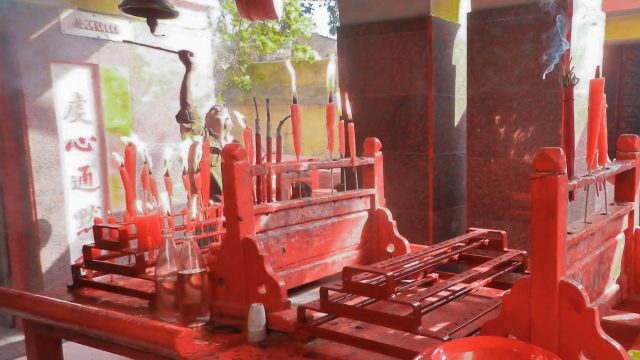It was the most drool-worthy sight. Tea, coke and exotic wines, fruits, cakes, biscuits, wafers, dumplings, dressed chickens … an array of foodstuff was neatly laid on a long table. A thin veil of aromatic smoke hung over the place as scores of incense sticks burnt in decorative red holders. As more pilgrims arrived, the food pile got bigger and the smoke more intense. And through the haze, the idols of Khuda-Khudi looked on benevolently at the arriving pilgrims and their offerings. It was awesome to watch the unfolding of a day-long festival, the only one of its kind in the world, at Achipur, lying to the south-west of Kolkata.
Narrow roads, traffic jams, a bustle of residential houses, shops, schools and markets – at first glance, there is little to distinguish Achipur from its neighbours. But it is here that on the Sunday after their Lunar New Year, members of the Chinese community of Kolkata head to pay respect to Tong Achew’s grave.

According to many reports, Atchew or Tong Achew was the first Chinese to settle down in Calcutta (as Kolkata was then known as) in the late 18th century. An entry in the Bengal District Gazetteers: 24 Parganas says Tong Achew was given a grant of land by East India Company’s Governor General Warren Hastings where he set up a sugar manufacturing plant.
In 1781, according to the Gazetteer entry, Atchew submitted a memorial to Governor General Hastings and members of the Supreme Council saying that his Chinese labourers were being enticed away by Chinese deserters from the ships to Calcutta. A notice was issued saying that ‘Atchew was under the protection of the Government and the Board wished to grant every encouragement to the colony of Chinese under his direction and were determined to afford him every support and assistance in detecting him to and bringing to condign punishment any ill-disposed persons who inveigled away the Chinese labourers in his employ, who were under indentures to him for a term of years.’
In a recent talk at the Indian Museum in Kolkata, Tansen Sen – director of Centre for Global Asia in New York University, Shanghai – said that Hastings had offered the parcel of land to Chinese trader Atchew (whose original name was Yang Dazhao) pleased with the latter’s consignment of tea.
Subsequently, Kolkata became home to a large number of Chinese people, who not only engaged in various occupations but also added a new chapter to the evolution of Chinese cuisine. Even though the number of Chinese have gone down in the past couple of decades, not only the people residing in Kolkata but also those who have migrated to distant cities, arrive to pay their respect to Tong Achew.
The first stop is the Temple of the Earth God and Goddess located in the middle of Achipur town, about 30km by road from Kolkata and near the town of Budge Budge.

The temple complex is easily identifiable by the decorative gate with the name of the temple inscribed on it. The low-roofed temple sits at one side of a field. It consists of the sanctum sanctorum housing the idols and is fronted by a quadrangle with a roof. Around the quadrangle are a couple of prayer halls and a long corridor. Chinese calligraphy adorn the walls. The table for food offerings and the elaborate incense stick holders are laid in front of the sanctum in the quadrangle.
Although little is known about the temple and the twin idols, it is believed that the idols were brought by Achew as guardian deities. With our eyes watering from the smoke, we could just about make out the two small idols in their typical Chinese hats, popularly known as Khuda Khudi or the Earth God and Goddess.
Prayers, burning incense sticks and candles, and laying out the food offering are the main rituals followed by the pilgrims. Some hit a drum hanging in front of the sanctum. Many pilgrims were folding envelopes with Chinese calligraphy on them. Later, these envelopes are consecrated to a flame burning in a corner; carrying the inscribed prayers to the deceased family elders, explained one of the pilgrims.
There is also a small shrine behind the main temple, apparently dedicated to some Hindu god but I could not find out more about it.
The food on the table is later collected by those who had offered them and consumed with families and friends. There were electric cookers where one could cook the food. While the senior members conversed or got busy preparing the food, many youngsters went out to burst fire crackers in the field.

From the temple, everyone visits the grave of Tong Achew on the bank of the Hooghly (Ganga) river. The road lies through a brick kiln. Little is known about the strange-looking grave – a red horse-shoe shaped structure. Here too pilgrims follow the same routine of offering prayers, incense sticks and food, albeit on a smaller scale. The scenic river bank trills with the laughter of people as they pose for family pictures. The Chinese pilgrims are not averse to non-Chinese people visiting the temple or the grave, subject to maintaining discipline and not disrupting the rituals.
Getting there: Achipur is around 30km from Kolkata by road. One has to take the Budge Budge Trunk Road from Taratala, a suburban neighbourhood to the south of the city. But the journey can be a bit tedious with several crowded townships lying along the way and road construction work going on. Carry some snacks and drinking water as the local eateries may not always meet with required standards of hygiene. Washroom facility is available in the temple complex.




